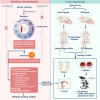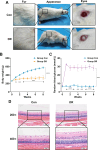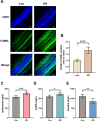Investigating the relationship between blood metabolites and diabetic retinopathy using two-sample mendelian randomization and in vivo validation
- PMID: 39362968
- PMCID: PMC11450153
- DOI: 10.1038/s41598-024-73337-4
Investigating the relationship between blood metabolites and diabetic retinopathy using two-sample mendelian randomization and in vivo validation
Abstract
We addressed fundamental questions about the influence of metabolites on the development of Diabetic retinopathy (DR), and explored the related pathological mechanism. Genome-wide association study (GWAS) database data for metabolites and DR were used to perform Mendelian randomization (MR) studies. The inverse variance weighting (IVW) was chosen as the primary analysis method. Sensitivity analysis was conducted using MR-PRESSO, leave-one-out and Cochran's Q test. Confounding factors were eliminated to ensure robustness. We also conducted metabolic pathway analysis. In vivo experimental validation was conducted using Sprague Dawley rats. The serum metabolites of the DR group rats and normal group rats were examined to evaluate the MR results. The screen identified eighteen metabolites associated with DR risk, twelve of which were known components. Seven metabolites were positively correlated with DR risk, while five could reduce it. Eight metabolites associated with proliferative DR (PDR) risk were identified, four of which are known components. Three of these were positively associated with PDR risk and one metabolite reduced PDR risk. Additionally, two possible metabolic pathways involved in the biological mechanism of DR were identified. The ELISA results showed that the serum levels of isoleucine and 4-HPA were significantly increased in DR rats, while the level of inosine was decreased. This study offers novel insights into the biological mechanisms underlying DR. Metabolites that are causally linked to DR may serve as promising biomarkers and therapeutic targets.
Keywords: Blood metabolites; Diabetic retinopathy; Hippurate; Inosine; Isoleucine; Mendelian randomization.
© 2024. The Author(s).
Conflict of interest statement
The authors declare no competing interests.
Figures







Similar articles
-
Causal relationships between blood metabolites and diabetic retinopathy: a two-sample Mendelian randomization study.Front Endocrinol (Lausanne). 2024 May 1;15:1383035. doi: 10.3389/fendo.2024.1383035. eCollection 2024. Front Endocrinol (Lausanne). 2024. PMID: 38752182 Free PMC article.
-
Causal association between cystatin C and diabetic retinopathy: A two-sample Mendelian randomization study.J Diabetes Investig. 2024 Nov;15(11):1626-1636. doi: 10.1111/jdi.14273. Epub 2024 Aug 12. J Diabetes Investig. 2024. PMID: 39135422 Free PMC article.
-
Causal association of circulating metabolites with diabetic retinopathy: a bidirectional Mendelian randomization analysis.Front Endocrinol (Lausanne). 2024 May 10;15:1359502. doi: 10.3389/fendo.2024.1359502. eCollection 2024. Front Endocrinol (Lausanne). 2024. PMID: 38800471 Free PMC article.
-
Causality of genetically determined metabolites on anxiety disorders: a two-sample Mendelian randomization study.J Transl Med. 2022 Oct 20;20(1):475. doi: 10.1186/s12967-022-03691-2. J Transl Med. 2022. PMID: 36266699 Free PMC article.
-
Advances in molecular epidemiology of diabetic retinopathy: from genomics to gut microbiomics.Mol Biol Rep. 2025 Mar 13;52(1):304. doi: 10.1007/s11033-025-10383-9. Mol Biol Rep. 2025. PMID: 40080283 Review.
References
-
- Cheung, N., Mitchell, P. & Wong, T. Y. Diabetic retinopathy. Lancet376(9735), 124–136 (2010). - PubMed
-
- Magliano, D. J. & Boyko, E. J. IDF Diabetes Atlas 10th Edition Scientific Committee. IDF DIABETES ATLAS [Internet] 10th edn (International Diabetes Federation, 2021).
MeSH terms
Substances
Grants and funding
LinkOut - more resources
Full Text Sources
Medical

